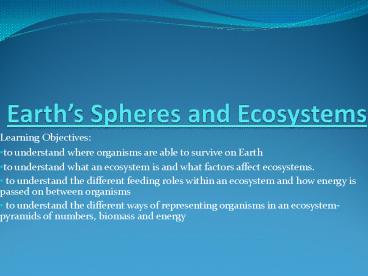Earth - PowerPoint PPT Presentation
Title: Earth
1
Earths Spheres and Ecosystems
- Learning Objectives
- to understand where organisms are able to survive
on Earth - to understand what an ecosystem is and what
factors affect ecosystems. - to understand the different feeding roles within
an ecosystem and how energy is passed on between
organisms - to understand the different ways of representing
organisms in an ecosystem- pyramids of numbers,
biomass and energy
2
Sustainability
- Sustainability refers to the living in a way that
ensures resources are available for a LONG time. - Sustainable ecosystems are natural and
undisturbed. They have characteristics that are
constant over long periods of time. - Unsustainable ecosystems are unnatural
(artificial) and disturbed. Humans must take care
of these ecosystems for them to survive (ex.
water and fertilize plants in them)
3
Ecosystems
- An ecosystem consists of the living organisms in
a region, their interactions with each other and
with their non-living environment. - Factors affecting ecosystems are
- biotic living organisms, their remains,
products and wastes. - abiotic non-living physical and chemical
components.
4
Earths Four Spheres
- Atmosphere the layer of gases (mainly nitrogen
and oxygen) surrounding the Earth. - Acts as an insulator, regulating Earths surface
temperature - Blocks incoming solar radiation
- Lithosphere Earths outer layer of solid rock.
- Consists of rocks, minerals and soil
- Hydrosphere all of the water on and below
Earths surface. - Water is in solid, liquid and gas form- 97 is
found in the oceans
5
Earths Four Spheres
- Biosphere the regions within the 3 other spheres
where life exists. - Very thin compared to Earths size.
6
Levels of Organization
- Organism- a single living being (plant or animal)
- Population- a group of the same type of organisms
living in an area - Community- a number of different populations of
organisms in an area - Ecosystem- the community of organisms and their
interactions with non-living substances in an area
7
Habitats
- A habitat is the place where an organism lives.
- There are two types of habitats
- Terrestrial on land
- Aquatic in water
8
- Producers create glucose (chemical energy) from
light energy. They do not need to consume other
organisms to get energy. - Consumers are organisms which need to eat
(consume) other organisms to get their energy.
They cannot perform photosynthesis.
9
Feeding Role Definition
Herbivore Animal which eats plants or other producers Ex Rabbit
Carnivore Animal which eats other animals Ex Lion
Omnivore Animal which eats both plants and animals Ex Bear
Scavenger Animal which feeds on the remains of another organism Ex Vulture
Decomposer Organism which feeds on and breaks down dead plant or animal matter Ex Fungus, Earthworms
10
- A food chain or food web shows how energy
transfers between organisms and through an
ecosystem by giving the order in which organisms
are consumed. - A food chain consists of a single pathway of
energy transfer. - The arrows show the direction energy is moving in
from one organism to its consumer.
11
- A food web contains many different feeding
relationships and energy transfer pathways.
12
- Trophic level- is the feeding level, or position
of the organism in the food chain. - Ex a producer is in the first trophic level
- Consumer level- is the position of the consumer
in the food chain. - Ex an herbivore is the primary (first) consumer
- producers do not have a consumer level, because
they do not consume other organisms to get energy.
13
- The more complex the food web of an ecosystem,
the more stable it is because there is more
biodiversity. This means each organism can get
its energy from a number of different sources.
Thus, if one food source disappears, its
predators have other prey to feed on.
14
Autotroph v. Heterotroph
Autotroph Heterotroph
Produce own Food Yes No
Food Chain Level Primary Secondary and Tertiary
Examples Plants, algae, some bacteria (producers) Herbivores, omnivores, carnivores, scavengers, and some bacteria (decomposers)
15
(No Transcript)































